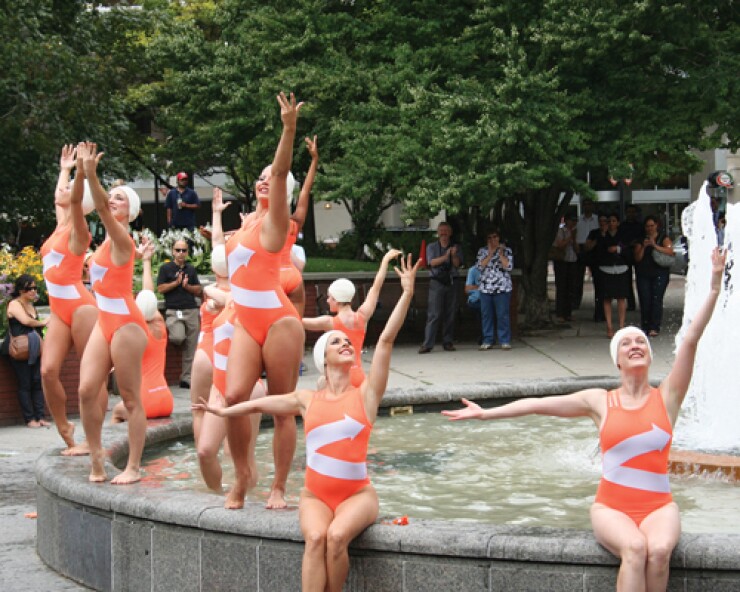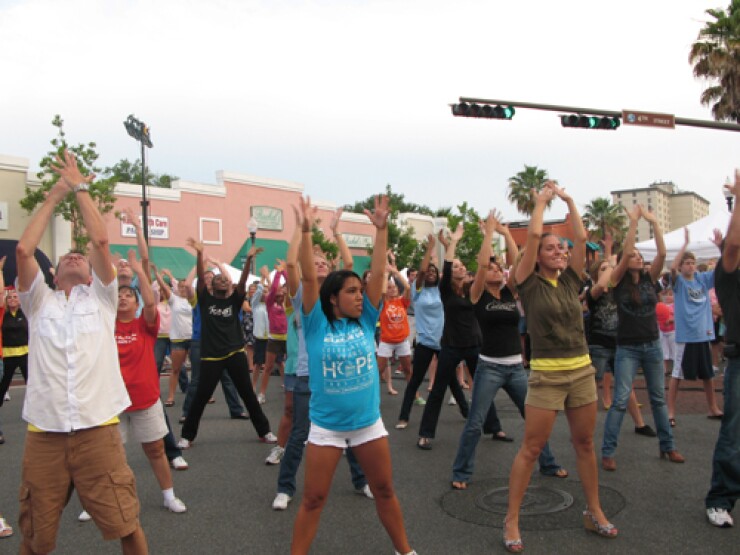


Innovations Federal Credit Union wants to live up to its name, even in its marketing. So when David Southall, its president and chief executive, saw a YouTube video of a flash mob performing at an airport terminal in Lisbon at Christmastime, it sparked an idea.
A new airport would be opening in the credit union's hometown of Panama City, Fla., in May and he wanted to do a flash mob of his own-a rarity in the financial services industry.
"We don't like to be traditional," says Southall, who began overhauling the $150 million-asset credit union several years ago to focus on attracting younger members. "Everything about us is different."
Southall ultimately pulled off the flash mob as he hoped with nothing to go on about how to do one other than the YouTube video. He wrangled a group of about 80 people-mostly credit union members and their friends-for a five-minute dance routine at the grand opening celebration for Northwest Florida Beaches International Airport.
But this was not a scheduled performance on a stage. As flash mobs do, the dancers emerged from the crowd as if they were strangers who came together spontaneously. Puzzled bystanders gathered around, whipping out their cameras and cell phones to take pictures.
"A flash mob is where a group of people come together suddenly, do a certain act, and then they go away just as suddenly, as if nothing ever happened," Southall says.
ING Direct Canada also used a similar tactic this summer to promote a new checking account, with the help of the digital marketing agency Dashboard. As in that YouTube video Southall saw-where airline employees delighted holiday travelers by dancing around the terminal and lip-syncing to music-the financial institutions opted for a dance performance, but that's not the only option.
A flash mob might burst out singing, as a Philadelphia opera company did at a busy market this spring. Or it might just freeze in place for a few minutes in a bustling train station, as one group of 200 people famously did in the main concourse at New York's Grand Central Station a few years ago. "You could really do just about anything," Southall says.
In organizing the events, Innovations and ING had much different approaches.
Innovations posted a casting call on its Facebook page for people who liked music and dancing. Since the element of surprise is essential for a flash mob, the credit union disclosed its plan only after those interested came to a meeting and agreed to keep everything a secret.
Some dropped out right away. Others got so excited they recruited friends. About 100 people turned out for practices over the next several months, coming as their schedules allowed to any of the three sessions each week. And most of them made it to the performance at the airport or a second one a few weeks later at a local street festival.
In contrast, ING hired a producer to manage the project and audition professional dancers. That's partly why Gayle Lunn, group account director at Dashboard, says she doesn't think of its performance-which surprised the lunchtime crowd at a Toronto park in August-as a true flash mob. The term generally refers to strangers who come together to create an event after a notice on the Internet.
Lunn considers the ING stunt more of a "flash performance." And it was just one of several tactics used on a single day to create buzz for the new Thrive checking account and prompt people to go to a microsite for more information (www.your185.ca).
The dancers wore orange bathing suits with the Web address printed on the back as they mimicked a synchronized swim routine at a fountain in the park. They picked up coins from the fountain and gave them to bystanders, before dashing off.
Brenda Rideout, ING's chief marketing and technology officer, says the point behind handing out the coins is that other checking accounts "nickel and dime" customers with assorted charges, unlike the fee-free, interest-bearing Thrive. She says the company found in a recent poll that about 25 percent of Canadians are unaware of how much they pay in bank fees, which averages $185 annually (the inspiration for the name of its microsite).
Rideout says the media picked up on the flash mob and ING's other attention-getting stunts that day.
But perhaps more importantly for its social media-savvy target, so did bloggers and people on Twitter.
In September ING selected 10,000 people to preview its checking account from those who went to the microsite and signed up to try it out before it officially launches early next year. "Our objective was to get people to register, and within 24 hours we had thousands and thousands of Canadians register," Rideout says.
For his more grassroots effort, Southall asked a local radio personality with dance training to help him pick the songs, choreograph the routine and get the volunteers ready to perform. He also made a DVD with her demonstrating the steps so the participants could use it to practice at home. "You want to come up with a dance that's not too difficult, because you're going to have people at all levels of dance ability," he says. "But you don't want to do something so simple it looks like you're doing aerobics either."
Southall hired a professional video crew to record the two performances, for posting on YouTube. ING did as well.
But neither accompanied the performances with aggressive marketing-which would not fit in with the concept of a flash mob. Southall supplied each dancer with a T-shirt that had the credit union's name on the back and its tag line, "Spark Change," on the front. They wore the shirts under other clothing at the start of the performance, revealing them about halfway through. And like the orange bathing suits in ING's case, that was the only promotional cue. "It's supposed to be entertainment," Southall says. "We didn't set up a booth and open new accounts. That wasn't what it was about."
But Innovations did add members as a result, from among the dancers, their friends and family, and the crowds that saw them perform, he says. The credit union also got publicity through the local news and social media.
Southall estimates the overall cost of the initiative at $2,500. "But that's nothing compared to the return," he says. "That type of advertising, you can't buy."





